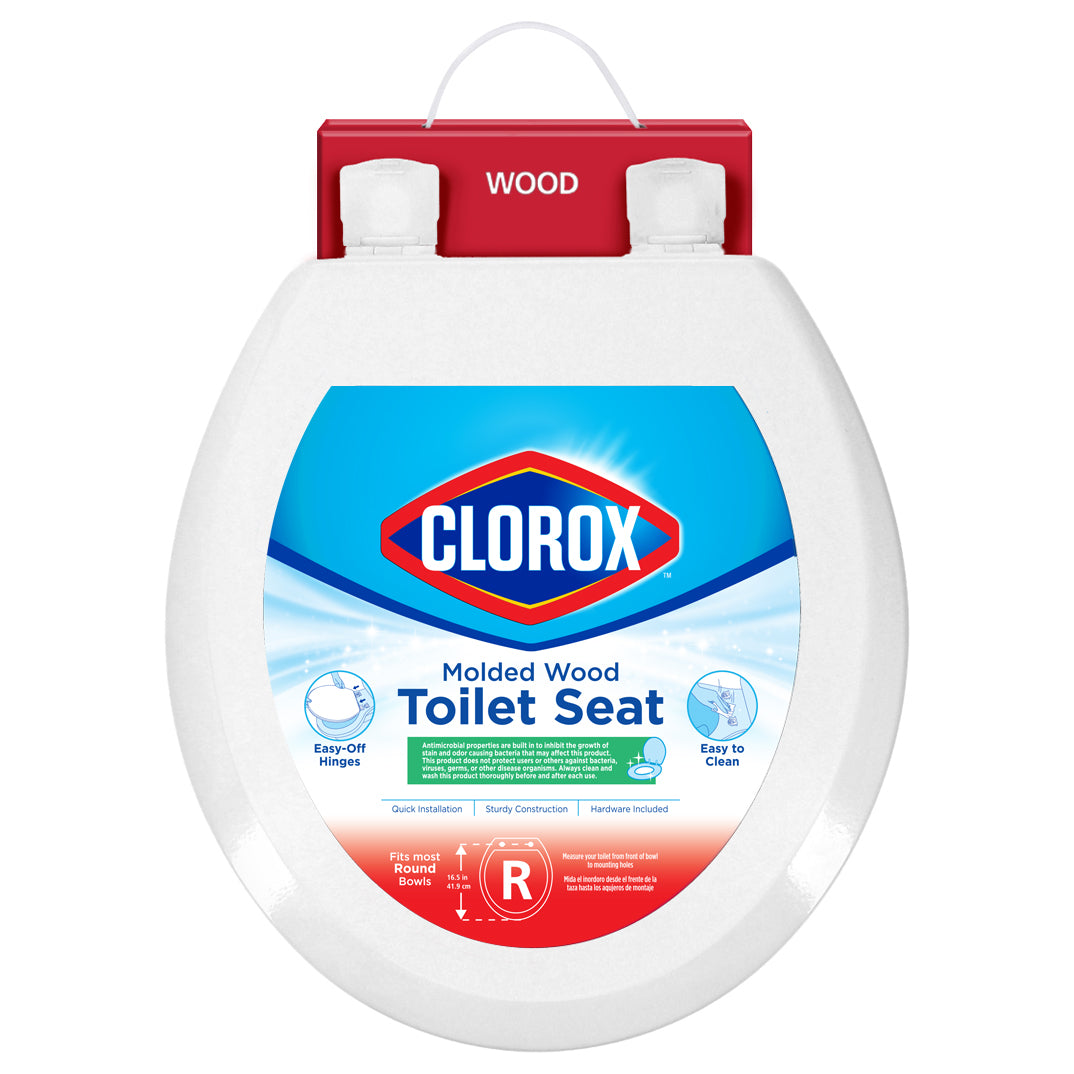To clean a wood toilet seat, use a mild soap and warm water solution. Wipe with a soft cloth and dry thoroughly.
Maintaining the cleanliness of your wood toilet seat is essential for hygiene and longevity. Wood toilet seats add a touch of elegance and warmth to your bathroom but require special care. Using harsh chemicals can damage the finish, so gentle cleaning agents are recommended.
Regular cleaning prevents the buildup of bacteria and grime, ensuring a fresh and hygienic bathroom environment. With the right approach, you can keep your wood toilet seat looking new and extending its life. Follow these simple steps to preserve its beauty and functionality for years to come.
Credit: www.tiktok.com
Materials Needed
Cleaning a wood toilet seat requires the right materials. With the right tools, the process becomes easy and effective. Below is a list of essential items needed to achieve a clean and germ-free wood toilet seat.
Cleaning Supplies
- Mild Dish Soap: Gentle and effective for removing dirt.
- White Vinegar: Natural disinfectant that kills germs.
- Baking Soda: Great for tackling tough stains.
- Soft Cloth: Prevents scratching the wood surface.
- Spray Bottle: For easy application of cleaning solutions.
- Toothbrush: Helps clean hard-to-reach areas.
Protective Gear
- Gloves: Protect your hands from cleaning chemicals.
- Face Mask: Shields from inhaling fumes.

Credit: www.ginsey.com
Preparation Steps
Before cleaning a wood toilet seat, preparation is key. Proper steps ensure effective cleaning and protect the wood surface.
Clear The Area
First, remove items around the toilet. This includes rugs, toilet paper, and any decorations. Clearing the area prevents contamination and provides space to work.
Gather Materials
Next, gather all necessary materials. Having everything ready saves time and makes the process smoother.
| Material | Purpose |
|---|---|
| Mild soap | For gentle cleaning |
| Warm water | To mix with soap |
| Soft cloth | For wiping the seat |
| Baking soda | For stubborn stains |
| Vinegar | For disinfecting |
| Gloves | To protect your hands |
Once all materials are ready, you can proceed with cleaning. Proper preparation ensures the wood toilet seat remains in good condition.
Daily Cleaning Routine
Maintaining a clean wood toilet seat is essential for hygiene. A daily cleaning routine ensures your toilet seat stays spotless and germ-free.
Wiping Down
Start your daily routine by wiping down the toilet seat. Use a soft cloth or paper towel. Make sure to reach all areas of the seat.
Focus on the top, sides, and hinges. This quick wipe removes dust and minor stains.
Using Mild Cleaners
Choose a mild cleaner for your wood toilet seat. Avoid harsh chemicals that can damage the wood. Mix a small amount of mild soap with water.
Dip a soft cloth into the soapy water. Wipe the seat gently, covering all areas. Rinse the cloth with clean water and wipe the seat again. This removes any soap residue.
Dry the seat with a soft, dry cloth. Keep the wood from absorbing too much moisture.
| Step | Action |
|---|---|
| 1 | Wipe down with a soft cloth |
| 2 | Use mild soap and water |
| 3 | Rinse and dry thoroughly |
Follow these steps daily for a clean and fresh wood toilet seat. Regular cleaning keeps your bathroom hygienic and pleasant.

Credit: www.amazon.com
Deep Cleaning Techniques
Wood toilet seats require special care to keep them clean and sanitary. Regular cleaning helps maintain their appearance and longevity. This guide will show you how to deep clean a wood toilet seat. Follow these steps for a sparkling clean seat.
Stain Removal
Stains on a wood toilet seat can be unsightly. Here’s how to remove them effectively:
- Mix equal parts of baking soda and water to form a paste.
- Apply the paste to the stained areas using a soft cloth.
- Gently rub the paste into the stains in a circular motion.
- Let it sit for 10 minutes to break down the stain.
- Wipe away the paste with a clean, damp cloth.
- Repeat if the stain persists, but avoid scrubbing too hard.
Disinfecting
Disinfecting your wood toilet seat is crucial to prevent germs and bacteria. Here’s a simple way to disinfect:
- Fill a spray bottle with a solution of white vinegar and water in equal parts.
- Spray the solution generously over the entire toilet seat.
- Let it sit for 5 minutes to kill germs.
- Wipe the seat with a clean, damp cloth to remove the solution.
- Dry the seat with a soft, clean towel.
For a deeper disinfection:
| Ingredients | Instructions |
|---|---|
| Hydrogen Peroxide | Spray hydrogen peroxide on the seat and let it sit for 10 minutes. Wipe it off with a damp cloth. |
| Tea Tree Oil | Add a few drops of tea tree oil to a spray bottle with water. Spray the seat and wipe it down after 5 minutes. |
Regular deep cleaning of your wood toilet seat ensures it remains clean and germ-free. Follow these techniques for the best results.
Natural Cleaning Alternatives
Cleaning a wood toilet seat with natural alternatives is safe and effective. These methods use household items you already have. They are gentle yet powerful in removing dirt and germs.
Vinegar Solution
Vinegar is a great natural cleaner. It is both antibacterial and antifungal. To make a vinegar solution, mix equal parts of white vinegar and water in a spray bottle.
Follow these steps to clean your wood toilet seat:
- Spray the vinegar solution on the toilet seat.
- Let it sit for 10 minutes.
- Wipe it off with a clean cloth.
For tough stains, use a soft-bristle brush. Gently scrub the area to avoid scratching the wood. Vinegar also helps to remove odors, leaving your toilet seat fresh.
Baking Soda Paste
Baking soda is another fantastic natural cleaner. It is mildly abrasive and can remove stains without damaging the wood.
To make a baking soda paste, mix baking soda with a small amount of water. You need to form a thick paste.
Here is how to use the baking soda paste:
- Apply the paste to the stained areas.
- Let it sit for 5-10 minutes.
- Gently scrub with a soft cloth or sponge.
- Wipe off the paste with a damp cloth.
Baking soda paste is excellent for tough stains and grime. It ensures your wood toilet seat remains clean and well-maintained.
| Cleaning Method | Ingredients | Steps |
|---|---|---|
| Vinegar Solution | White Vinegar, Water |
|
| Baking Soda Paste | Baking Soda, Water |
|
Avoiding Common Mistakes
Cleaning a wood toilet seat can be tricky. It’s important to avoid common mistakes. These mistakes can damage the wood. This section will help you clean your wood toilet seat correctly.
Harsh Chemicals
Many people think harsh chemicals clean better. This is not true for wood. Harsh chemicals can strip the wood’s finish. This makes the wood look dull and old. Use mild soap and water instead.
Here is a simple cleaning solution:
- 1 cup warm water
- 1 teaspoon mild dish soap
Mix these ingredients together. Dip a soft cloth into the solution. Wipe the toilet seat gently. This will clean the seat without harming the wood.
Abrasive Scrubbing
Another common mistake is using abrasive scrubbers. Abrasive scrubbers can scratch the wood. These scratches can lead to more damage.
Use a soft cloth or sponge instead. A microfiber cloth works well. It cleans the surface without scratching.
Here is a simple cleaning routine:
- Wet the cloth or sponge with warm water.
- Add a small amount of mild soap.
- Wipe the seat gently.
- Rinse the cloth and wipe again to remove soap.
- Dry the seat with a soft, dry cloth.
Following these steps will keep your wood toilet seat clean and shiny.
Maintaining Wood Finish
Maintaining the wood finish of your toilet seat keeps it looking new. Proper care ensures longevity and adds elegance to your bathroom. Let’s explore two essential steps for maintaining the wood finish: Polishing and Sealing.
Polishing
Polishing helps maintain the shine and smoothness of the wood. Regular polishing removes dust and grime, preventing damage.
- Use a soft cloth to apply wood polish.
- Choose a polish suitable for wood surfaces.
- Apply a small amount of polish to the cloth.
- Rub the polish onto the wood in circular motions.
- Wipe away any excess polish with a clean cloth.
Polishing once a month keeps your toilet seat shiny and smooth. Avoid using abrasive cleaners as they can damage the finish.
Sealing
Sealing protects the wood from moisture and stains. A good sealant creates a barrier, keeping the wood safe.
- Clean the wood thoroughly before sealing.
- Use a brush to apply the sealant evenly.
- Allow the sealant to dry completely.
- Apply a second coat if necessary.
- Let it dry for at least 24 hours.
Sealing every six months provides long-lasting protection. Choose a sealant designed for wood to ensure the best results.
Here’s a quick comparison of polish and sealant:
| Aspect | Polish | Sealant |
|---|---|---|
| Frequency | Monthly | Every 6 months |
| Purpose | Shine and smoothness | Protection from moisture |
| Application | Soft cloth | Brush |
Following these steps ensures your wood toilet seat remains in excellent condition. Proper maintenance is key to preserving its beauty and functionality.
Tips For Longevity
Keeping your wood toilet seat clean can ensure it lasts longer. Here are some essential tips to help you maintain it properly.
Regular Maintenance
Regular maintenance keeps the wood toilet seat in good shape. Use a soft cloth to wipe it down weekly. Avoid using harsh chemicals. Instead, use a mild soap and water mixture. This helps preserve the wood finish.
Dry the seat thoroughly after cleaning. Moisture can damage the wood over time. You can also use a wood polish to enhance the shine and protect the finish.
Immediate Spill Cleanup
Clean up spills immediately to prevent stains. Use a damp cloth to blot the spill. Avoid rubbing, as it can spread the liquid. Dry the area with a soft, dry cloth.
If the spill leaves a stain, use a mild soap solution. Gently clean the stained area. Dry it thoroughly to prevent moisture damage.
Frequently Asked Questions
How Do You Get Urine Stains Out Of A Wooden Toilet Seat?
Clean urine stains from a wooden toilet seat using a mixture of vinegar and water. Scrub gently with a soft cloth. Dry thoroughly to prevent damage.
Can You Use Clorox Wipes On Wooden Toilet Seat?
No, you should not use Clorox wipes on a wooden toilet seat. They can damage the wood. Use mild soap and water instead.
Are Wooden Toilet Seats Easy To Clean?
Yes, wooden toilet seats are easy to clean. Use mild soap and water. Avoid abrasive cleaners to prevent damage. Regular maintenance keeps them hygienic.
How Do You Get Yellow Stains Out Of Wooden Toilet Seats?
To remove yellow stains from wooden toilet seats, use a mixture of baking soda and water. Scrub gently with a soft cloth.
How Often Should I Clean A Wood Toilet Seat?
It’s best to clean a wood toilet seat weekly to maintain hygiene and preserve the wood.
Conclusion
A clean wood toilet seat enhances bathroom hygiene and aesthetics. Regular maintenance preserves its beauty and longevity. Use gentle cleaners and soft cloths for best results. Avoid harsh chemicals to prevent damage. With these tips, your wood toilet seat will remain pristine, providing comfort and style for years to come.





